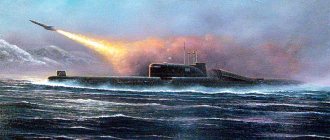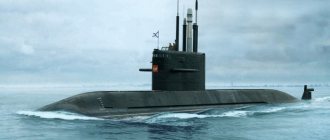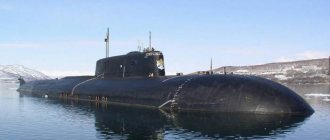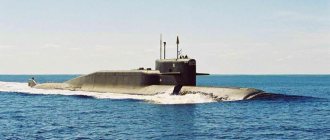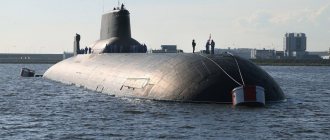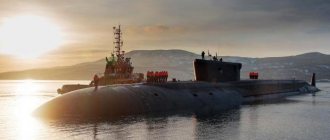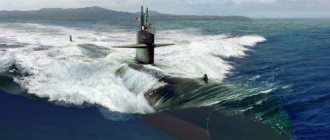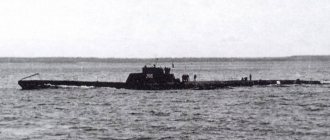Project 877 Halibut ships are a series of Soviet and Russian diesel-electric submarines, the development of which began in the 70s of the last century. The first ship was laid down in Komsomolsk-on-Amur in 1979 and launched in 1982. Project 887 submarines belong to the third generation of diesel-electric submarines.
These submarines are often called “Varshavyanka”, although this is not entirely accurate. Officially, Varshavyanka is a Project 636 submarine, which is a further development of the Halibut, its export modification. The second reason for such confusion in names is the fact that the Soviet Union initially planned to arm its Warsaw Pact allies with these submarines.
Currently, the Russian Navy includes 15 submarines of projects 877, 877LPMB, 877V and 877EKM. They are also in service with the navies of Algeria, Poland, Romania, India, China and Iran.
Submarines of projects 877 and 636 turned out to be so successful that they are still the main non-nuclear submarines of the Russian fleet. Moreover, their production continues to this day. For its low noise and invisibility in the West, “Varshavyanka” received the name “Black Hole”.
Project 877 Halibut diesel-electric submarines
In the 1970s, it was decided to replenish the Navy with diesel-electric submarines of a new generation, which needed to operate against submarines and surface ships, lay minefields, and conduct reconnaissance. Submarines must be relatively small, high-speed, low-noise, and have advanced radio, sonar and electronic equipment. Since such submarines were going to be delivered to the allies under the Warsaw Pact, in addition to the usual project number - 877, she was given a proper name - “Varshavyanka”.
Submarine B-871 "Alrosa" pr.877B KILO enters the roadstead of Cartagena (Spain) to participate in the "Bold Monarch 2011" maneuvers jointly with NATO fleets. May 25, 2011 (photo from the archive of Vladimir Vladimirovich, https://ejercitos.org)
Their development in 1974, according to the specifications approved by the USSR Navy, was carried out by the designers of the Rubin Central Design Bureau, headed by Yu.N. Kormilitsyn together with the Research Institute named after. Krylova. If Project 641 boats were traditionally narrow and long, the outer and lightweight hull was spindle-shaped, with a round bow configuration like a nuclear submarine. The hull itself was designed in such a way that hydrodynamic resistance was minimal. Several models were tested and perfected in the test pool and on test benches.
The design of Project 877 Halibut submarines is double-hulled. The shape of the housing was maximally adapted to reduce noise and resistance.
The durable body is made in the form of a cylinder, the cross sections are circular. The body end structures are spherical. Strong waterproof bulkheads divide the hull into six compartments: 1st – bow, used to accommodate torpedo tubes; 2nd – main command post and batteries; 3rd – double-deck, residential, galley and cabins on the upper deck, batteries on the lower deck; 4th – diesel generators; 5th – propulsion electric motors; 6th – backup power plant and electric motors for economic propulsion.
AK-25 steel was used to make a durable case.
Submarine pr.877EKM serial number 01325 Sindhurakshak of the Indian Navy during testing after repair with modernization at the Zvezdochka shipyard in Severodvinsk, 11/25/2012 (photo - Zvezdochka CS, https://zvezdochka-ru.livejournal.com/)
The lightweight body was given a streamlined, spindle-shaped “Albacore” shape. A special coating absorbs radiation from enemy hydroacoustic systems. Main ballast tanks, other tanks, as well as various equipment are located in the double-hull space. Although, due to the double-hull design, the submarine has a significant underwater volume, in emergency situations this makes it possible to increase survivability by ensuring unsinkability with large submerged volumes of the ship. In the cruising position, the submarine can remain afloat even if any compartment and two adjacent main ballast tanks on one side are flooded.
The fencing of the retractable device shafts is located approximately in the middle of the ship. A navigation bridge is also equipped in it. All retractable devices, with the exception of the commander's periscope, are made not to penetrate the durable casing. Thanks to this, the central post was made more spacious and convenient for controlling the ship and its combat systems.
The bow horizontal rudders were also retractable. To reduce the interference they cause in the operation of the hydroacoustic complex, they were moved from the bow to the middle part of the hull. Also, the scuppers were removed from the bow end, and all mechanisms that emitted noise from the first compartment were removed.
The main power plant was designed according to a full electric propulsion scheme, that is, in the surface and submerged positions, the movement is provided by a propeller electric motor.
The main power plant includes: - main propulsion electric motor PG141 (power 5500 hp). The B-800 submarine and Project 636 boats are equipped with a low-speed PG165 engine of the same power. — 2 diesel generators 4DL-42МХ (power of each 1500 kW, the first two submarines of Project 877 were equipped with 2х4DL-42М power of each 1000 kW) with a system for operating the diesel generator under water. The 877M and 636 modifications are equipped with a 30DG diesel generator (one power of 1500 kW), which also operates with a RDP. — two groups of lead-acid batteries.
For economy mode The propeller is powered by a special 190-horsepower electric motor PG142. Starting with the submarine B-800/project 877В/project 636, a low-speed 190-horsepower PG166 engine is installed.
Submarine B-871 "Alrosa" pr.877V KILO and a disassembled water-jet propulsion unit. Sevastopol, floating dock PD-30, regular repair, January 12, 2006 (photo - Dmitry Stogniy, https://forums.airbase.ru)
A design feature of Project 877 submarines is the presence of a pair of backup 102-horsepower electric motors PG-168. These engines provide the boat with movement in narrow places, allow maneuvering during mooring, and can also be used for propulsion in the event of damage to the main shaft and propeller.
A low-speed six-blade fixed-pitch propeller is used as a propulsion device. On boats B-470 and B-800 there is a 7-blade made of Aurora alloy with saber-shaped blades. On the sides in the rear part of the hull there are thruster water jets. The process of diving/surfacing of a submarine is automated.
When moving underwater, the submarine develops a maximum speed of 17 knots, while on the surface – 10 knots. The underwater cruising range at a speed of 7 knots in diesel operating mode is 6,000 miles; at an economical speed at a speed of 3 knots in a submerged position, the boat can cover 400 miles.
Starting with the B-800 submarine, they are equipped with an escape hatch, which allows you to leave the flooded submarine from depths of up to 250 meters (made in the stern).
Energy – two groups of lead-acid batteries with 120 elements each. Project 636M submarines use batteries that have a service life increased by 2.5 times while maintaining the same power.
The boats were equipped with an improved navigation system. Various modifications of Project 877 “Halibut” are equipped with the Andoga, Apassionata-EKM, and Apassionata-EKM.1 complexes. To search for surface targets and monitor the air situation, a radar station is used, as well as means that detect radiation from enemy radars. Hydroacoustic equipment – active and passive. Information from all surveillance equipment and posts enters the multi-purpose BUIS (“Lama” / “Knot”, “Lama-EKM” / “Knot”), is processed by a computer, and then transferred to the commander’s disposal, to the command post, which is isolated from other compartments . General ship systems are controlled from the Palladium or Palladium-EM control panel (depending on the modification).
Loading torpedo 53-65КЭ on the submarine pr.877EKM KILO Chinese Navy (https://cnair.top81.cn)
Loading a Club-S missile into the torpedo tube of the Indian submarine pr.08773. For loading, a platform attached to the submarine hull is used (photo taken no later than 2009, https://forums.airbase.ru)
Most of the mechanisms are equipped with vibration-absorbing coatings and mounted on shock absorbers, others are arranged on special platforms in blocks, which, together with a low-noise propeller and a streamlined hull, makes the submarine less noticeable compared to other types of submarines.
The submarine is armed with six 533-mm torpedo tubes located at the bow. Of these, two devices in the upper tier are designed to fire remote-controlled torpedoes. Control and reloading (the Murena fast recharging device is used) is remote with a gearbox. Loading of torpedoes was carried out using a special loading device. Ammunition - 18 torpedoes, 6 of which were in torpedo tubes, 12 - on racks. Torpedoes 53-56B, 53-56BA, 53-65K, SET-53M, TEST-71M, SET-65E, USET-80K could be used. Instead of torpedoes, 24 DM-1 mines could be taken on board: 12 mines for torpedo tubes (2 per tube) and the same amount for racks.
For air defense, Project 877 submarines that were part of the Soviet Navy were armed with the Strela-3 retractable anti-aircraft missile system (during the modernization process, Strela-3M and Igla-1 9M313 were installed). The complex's ammunition capacity is 8 missiles.
Projects 08773, 636M/06361 used the Club-S missile system with the launch of cruise missiles from the upper tier torpedo tubes from an underwater position. Ammunition - 4 missiles. Project 06363 used the Kalibr-PL missile system with missiles launched from an underwater position.
A powerful mine-torpedo weapon system can solve multi-purpose tasks. It ensures firing of ammunition at any diving depth and, together with the BIUS, allows not only single, but also salvo firing at 2 targets.
In Komsomolsk-on-Amur in 1979, the shipyard began building the lead submarine of Project 877, and it went into operation in September 1982. Later, ships of this project were produced in Leningrad, as well as on. After they were spotted by foreign observers in 1981, NATO gave them the designation "Kilo."
Construction of the series for the Navy continued after 1992. During the construction process, the project was constantly improved. For example, the B-800 submarine (created according to project 877LPMB) had a saber-shaped seven-blade propeller made of Aurora alloy. This submarine was the first of the 877 project to be equipped with an escape hatch and a system that made it possible to exit the submarine from a depth of 250 meters. Other equipment in the warhead-5 was made on a new element base. The submarine received a low-speed main propeller electric motor and an electric propulsion engine and other innovations, as well as additional acoustic equipment from the MGK-400 hydroacoustic complex (for this purpose, the SPK cabin was even reduced), new navigational equipment not included in the navigation complex, and so on.
The last eight ships of the series were built according to a slightly modified design. Thanks to the increase in the hull of the boat by two spacing (2x600 mm), more powerful diesel generators were mounted on them (1.5 times), with improved shock absorption of the platform, a Hall anchor that was retracted inside, and a low-speed main electric motor. In total, 30 pieces of equipment were replaced with new ones that are more maintainable and quieter. The service life of equipment has doubled, and the maintainability of ships has improved.
Submarine pr.877 (probably pryu877EKM B-806) with a diesel generator running under the RDP, Baltic Sea, 09.10.2007 (photo by Alex Suetin, https://fotki.yandex.ru)
Modifications: Project 877 “Halibut” (subseries 08770) – the basic production version of the submarine, head ones – B-248, B-401. In addition to the 08770 series, there were the 08771 or 08772 series - which differed between manufacturing plants. Project 877E “Varshavyanka” is an export modification of the Project 877 submarine of the first series. Delivered to Warsaw Pact countries. It differs mainly in equipment and is not equipped with an air defense system. Project 877EK - submarines were not built, is an “export commercial” version adapted to tropical operating conditions. Project 877EKM is an “export commercial modernized” version of the Project 877 submarine. Deliveries were made to Algeria, India, Iran and China. The MGK-400E hydroacoustic system was installed. The project was adapted to tropical operating conditions. In 1999, the Indian Navy was modernized and designated Project 08773. Modification of equipment and weapons systems (equipped with Club-S cruise missile launchers). Received the Lama-ER control system, the new MGK-400EM/MGK-EM sonar system, and the Palladium-M combat information and control system. On the modification of the submarine, the rudder group and design were kept similar to the 877EKM project. Project 877LPMB (B-800 "Kaluga") - is equipped with a 7-blade propeller made of Aurora alloy with saber-shaped blades. An escape hatch was also equipped, which allows evacuation from a depth of up to 250 m. The equipment of the BC-5 was redesigned, the economical propulsion engine and the main propulsion motor were lower speed. Additional navigational equipment was installed on the boat. Project 877B - equipped with a water-jet propulsion system. The main tactical and technical characteristics are similar to Project 877. Project 877M "Halibut-M" - the last 8 submarines of the Project 877 series for the domestic navy. The hull is lengthened by 1.2 m. Project 877B is a modernization project for the Project 877 submarine. Research and development work was carried out in the 1980s on the basis of Project 877M. Based on this project, the experimental submarine B-90 Sargan was laid down, later completed under Project 20120. Projects 877K/877MK are modernized projects 877 and 877M. after upgrading the equipment (in particular the combat information and control system). Project 636 - developed by the Rubin Central Design Bureau, is an export modification of Project 877M for the Chinese Navy, the equipment is modernized according to the type of Project 877M, sound-absorbing technologies are widely used. Project 636M is a modernized version of Project 636. The composition of the equipment has been changed, an inertial navigation complex, a periscope with a laser range finder, a TV channel and a night vision channel have been installed. Towed communication antenna for HF and VHF bands. Club-S cruise missiles can be used, launched through torpedo tubes from an underwater position. Project 06361 - modification of a submarine for the Vietnamese Navy. Project 06363 – modification of the project with updated equipment. Armed with the Caliber missile system. The project of a special submarine based on Project 877 is probably intended to carry out work on laying pipelines along the seabed. Possibly, once equipped, it can be used for a wide range of jobs.
Project 877 Halibut submarines and their modifications were delivered to: Algeria - 2 Project 877EKM submarines; India - 9 submarines of project 877EKM (8 modernized by 08773) + 1 built by project 08773; Iran - 3 submarines 877EKM; China - 1 submarine of Project 636M + 2 submarines of Project 877EKM; Poland - 1 submarine of project 877E; Romania - 1 submarine of project 877E.
Submarine B-464 "Ust-Kamchatsk" pr.877 (modernized) in the floating dock (https://forums.airbase.ru)
The Russian Navy has 24 Project 877 Halibut diesel-electric submarines and their modifications.
Performance characteristics:
(2000) Surface displacement - 2300 tons (project 636/636M - 2350 tons); Underwater displacement - 3040 tons (project 636/636M - 3100 tons); Maximum length – 72.6 m (projects 877М/636/636М – 73.8 m); Buoyancy reserve – 32%; Durable hull length – 51.8 m; Maximum width – 9.9 m; Draft along the vertical line – 6.2 m; Main power plant: - number and power of diesel engines - 2x1000 kW, type DL42MH (on the last 8 boats 2x1500 kW type 30DG); - number and power of the main motor - 1x5500 hp, type PG-141 (on the last 8 boats 1x5500 hp of the PG-165 type, on 877EKM - 1x4050 hp) - number and power of the EH electric motors - 1x190 hp. With. (PG-166); — number and power of backup propulsion engines – 2x102 hp. (PG-168); — propulsors – low-noise fixed pitch propeller; - fuel reserve - 172 tons; — number of battery groups, number of elements – 2x120; Surface speed -10 knots (project 636/636M - 11 knots); Underwater speed – 17 knots (on the last 8 – 19 knots); Economic underwater speed – 3.0 knots; Submarine range (speed 7 knots, under RDP) - 7500 miles (projects 636/636M with increased fuel reserve); Underwater range (speed 3 knots) – 400 miles; Underwater range (speed 21 knots) - 12.7 miles; Operating diving depth - 240 m (projects 636/636M/877M - 250 m) Periscope diving depth - 17.5 m (maximum sea level 5); The maximum immersion depth is 350 m (projects 877EKM/636/636M – 300 m); Autonomy – 45 days; Crew - 57 people (projects 877EKM/877V/636/636M - 52 people), incl. officers - 12; Armament: - missile system (project 08773) - Ciub-S; - bow torpedo tubes - 6 pcs.; — caliber — 533 mm — number of torpedoes — 18 (SET-65E, 53-65K, TEST-71M, USET-80K); - number and type of mines (instead of torpedoes) - 24 pcs., DM-1; — MANPADS — “Strela-ZM”/“Igla-1”; State identification radar station - "Nichrome-M".
The first submarine for the Vietnamese Navy, pr.06361, serial number 01339, at the outfitting wall of the Admiralty Shipyards, St. Petersburg. 09/20/2012 (photo - havron, https://forums.airbase.ru)
Light hull structures of the submarine B-261 "Novorossiysk" pr.06363 at the Admiralty Shipyards. St. Petersburg, published November 27, 2012 (photo - Vyacheslav Stepanov, https://gelio-nsk.livejournal.com)
Launching after repair of the submarine Taregh pr.877EKM Iranian Navy, May 28, 2012 (photo - Azin Haghighi, https://imp-navigator.livejournal.com/)
Prepared from materials: https://militaryrussia.ru https://www.deepstorm.ru https://army.lv https://nashflot.ru https://www.warships.ru
Development history
Submarine "Varshavyanka"
The development of Project 636 began in the USSR in the 1970s. It was then that the technical specifications were drawn up; the new boat was supposed to counteract enemy submarines and surface ships. The submarines of this project were supposed to be built for export to the Warsaw Pact countries, which is why they received the name “Varshavyanka”.
Despite the long deadlines, the construction of Project 636 ships began only in the mid-1990s. The main customer was China, two boats were assembled for Algeria. The modified model 636.1 was assembled for Vietnam and Algeria, and the possibility of deliveries to India was considered.
Since 2010, the construction of submarines for the Russian Navy began, the project received the number 636.3. Six submarines have already entered service, the seventh will be commissioned in November-December 2022, the eighth is being prepared for launch, and two more are under construction.
Project 877 “Halibut” is highlighted separately. These submarines are also called “Varshavyanka”, since some of them were exported to the Warsaw Pact countries. When considering technical characteristics, we focus on both projects due to their similarities.
Advantages and disadvantages
Varshavyanka submarines continue to enter service with the Russian fleet
The key advantage of the Varshavyanka submarines is their stealth. The design features of the submarine, combined with low-noise engines, allow it to approach targets almost closely, remaining invisible to most detection means.
These aspects, combined with their own detection range, make submarines the optimal choice in the fight against enemy ships. In most cases, it is the delivery of the first blow and the ability to escape the return that decides the outcome of the battle.
Another advantage is the Kalibr anti-ship missiles, which are capable of hitting surface targets from under water. This greatly expands the range of combat capabilities of the submarine. Additionally, the likelihood of using the Varshavyanka at any latitude is also indicated.
No direct disadvantages of this type of submarine have yet been identified. There are certain limitations in firepower, but these indicators are not considered critical. No shortcomings were identified during the combat use of the submarine.
Armament
"Varshavyanka" 636.3 in the parking lot
The armament of the Varshavyanka submarines is divided into the following categories:
- torpedo and mine shells;
- anti-ship missile launchers;
- air defense.
Air defense weapons are represented by Strela-3 or Igla MANPADS. Ammunition - 8 anti-aircraft guided missiles.
Six torpedo tubes
"Varshavyanka" has 6 torpedo tubes in the bow. Caliber - 533 mm, the system has an automatic supply of projectiles. The ammunition load includes 18 torpedoes.
Bottom mines
In addition to launching torpedoes, the submarine can place bottom mines. There are 24 of them in the ammunition load.
Anti-ship missiles "Caliber"
To engage surface targets, there are 4 installations for Kalibr anti-ship missiles. Anti-ship missiles ZM-54 are used. Export submarines were equipped with modifications ZM-54E and ZM-54E1.
Use in combat conditions and duty support
Boats of the Varshavyanka project are in service with China, Vietnam and Algeria. In the last decade, 6 boats entered service with the Russian fleet, most of them patrol the Black Sea. The seventh boat is also completing state tests. It is expected that in 2017-22, six boats will join the Pacific Fleet.
The first combat use of the submarine was recorded on December 8, 2015. The B-237 "Rostov-on-Don" from the Mediterranean Sea successfully fired Caliber-PL missiles at the positions of Syrian terrorists in the province of Raqqa.
